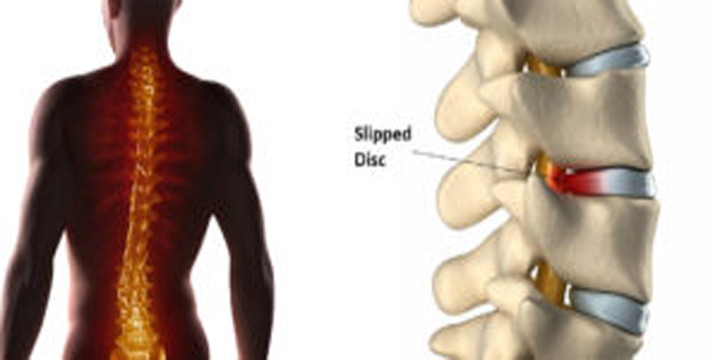What is Slipped Disc?
7 bones in the cervical spine, 12 bones in the thoracic spine, 5 bones in the lumbar spine followed by the sacrum and the coccyx at the base stacked onto each other make up our spinal column. These bones are protected by disks that absorb shocks from daily activities like walking, lifting, twisting and so on. Any abrasion or weakness can cause the inner portion of the disc to protrude through the outer ring that cause pain and discomfort and is known as slipped or prolapsed or herniated disc.
What are its symptoms?
Slipped disc in the neck
- Pain in the neck while movement
- Lack of sensation or a tingling sensation in the neck, shoulder, arm or hand
- Limited range of motion
Slipped disc in the lower back
- Pain in lower back while movement
- Lack of sensation or a tingling sensation in the back, buttocks, genitals, legs or feet
- Lower back pain is often the main symptom of a slipped disc caused by a disc pressing on a nerve, and may worsen when the nerve is under pressure while coughing, sneezing or sitting down
What causes disc prolapse?
Gradual, aging-related wear and tear: As you age, your spinal disks lose some of their flexibility gradually as a result of reduced moisture content. The discs tend to tear or rupture with even a minor strain or twist.
Injury or weakness: Any sudden injury can cause the inner portion of the disc to bulge outwards and In some cases compress one of the spinal nerves to cause disc prolapse.
When should I seek medical help?
- Aggravating symptoms: Intense pain that turns chronic and hampers your activities of daily living.
- Bladder or bowel dysfunction: Urination troubles (retention) or trouble holding it (incontinence).
What kind of medical help should I seek?
Conservative treatment:
- Avoiding painful positions
- Following a planned exercise
And, pain-medication regimen are supposed to bring down the pain due to slipped disc in a few weeks.
If the pain does not resolve within a few weeks, consulting a physiotherapist is suggested in those cases. Physical therapy has certain positions and exercises designed to reduce the pain of a herniated disk.
How does Physiotherapy help in the treatment of slipped disc?
Physical therapy often plays a major role in herniated disc recovery. Its methods condition the body to prevent further injury. Physiotherapy includes deep tissue massage, hot/cold therapies, hydrotherapy, and exercises bringing immediate pain relief. Taking into consideration the degree of pain and other symptoms there can be a range of therapies applicable.
- Electro stimulation: This method is followed by physical therapist it involves placement of an electrode closest to the region of disc slip.
- Laser light therapy: It involves a light of particular intensity that is supplied over the affected part.
- Ultra sound therapy: It is similar to that of laser light therapy but the difference lies in that it uses shock waves instead of light waves.
- Hot or cold therapy: Direct application of hot and cold packs reduce the symptoms and provide a soothing effect. Usually, this can be done readily on yourself at home.
Can slipped disc be prevented?
To help prevent a herniated disk:
- Following strengthening exercises to help stabilize and support the spine can avoid the risk of getting a slipped disc.
- Maintaining a good posture reduces the pressure on spine and disks. Using legs more than the back while lifting heavy objects, keeping the back straight while sitting for long hours, and more such correct postures can help avoid slipped or herniated discs.
- Maintaining appropriate body weight in order to avoid putting pressure on the spine can also help avoid slipped disc.
If you need further help or advice, give us a call. TriBeCa Care is happy to be by your side. Request a callback or Call us at + 913366064208.
Email us at enquiry@newwpsite.tribecacare.com

